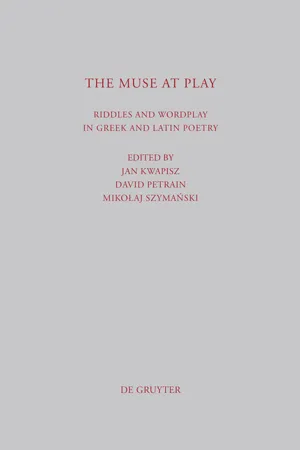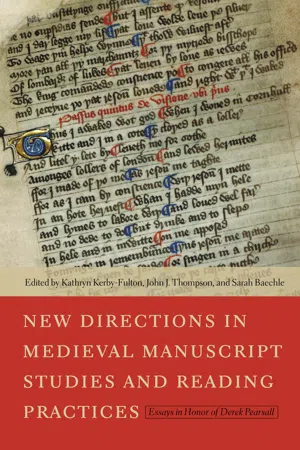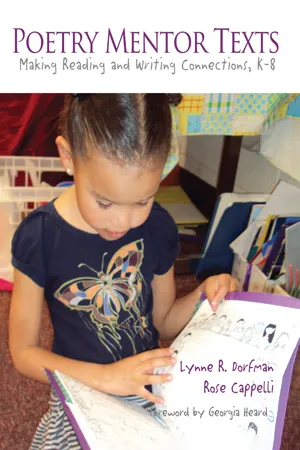Literature
Acrostic
An acrostic is a form of writing in which the first letter of each line, paragraph, or stanza spells out a word, message, or the alphabet. This technique is often used in poetry, literature, and puzzles to convey hidden meanings or messages. Acrostics can add an element of creativity and challenge for both writers and readers.
Written by Perlego with AI-assistance
4 Key excerpts on "Acrostic"
- Tremper Longman III and Peter Enns, Tremper Longman III(Authors)
- 2020(Publication Date)
- IVP(Publisher)
A
ACCUSER. See SATAN .ANTHROPOLOGY. See WISDOM THEOLOGY .AcrosticAcrostic is the term commonly applied to a composition in verse in which the initial letters of successive lines or stanzas are intentionally chosen either to outline a deliberate message (e.g., “Jesus Christ, God’s Son, Savior” [ichthys ,“fish”] in Sib. Or. 8:218-250) or to observe a traditional downward sequence of letters of the alphabet (e.g., from ʾālep to tāw in Ps 145). Acrostic can also specify the design itself, an artistic technique employed by biblical writers in poems of various genres. As a technique, it demonstrates that biblical Hebrew poetry has its disciplines, accenting the perennial tension in religious expression between freedom and constraint; although *parallelism may be biblical poetry’s chief characteristic, in poems that follow this design, Acrostic is the chief constraint. Nevertheless, most will agree with Muilenburg (103): “What is notable about this ancient poetry is that such an artificial contrivance does not stand in the way of producing literature of a high order, in which the emotions find full expression and the language bodies forth the intensity and passion of the poet.”Acrostic is both a creative technique of biblical Hebrew poetry and the broad label for a limited number of carefully crafted canonical poems that, in a variety of ways, effectively employ this technique. The Acrostic technique provides a precise design for the poet, facilitating a recital of verse capable of captivating the audience and enabling the listener to follow the movement of the poem from beginning to end. In compositions such as Psalm 119 and Lamentations 3 the listener detects the Acrostic pattern effortlessly—a definite appeal is made to the ear. But an Acrostic composition, which presupposes not only the invention of the Hebrew alefbet- eBook - PDF
The Muse at Play
Riddles and Wordplay in Greek and Latin Poetry
- Jan Kwapisz, David Petrain, Mikolaj Szymanski, Jan Kwapisz, David Petrain, Mikolaj Szymanski(Authors)
- 2012(Publication Date)
- De Gruyter(Publisher)
In this perspective, the Acrostic appears as the result of an interesting mixing of some local pre-Hellenic traditions and the Greek poetic and epigraphic tradition. In particular, the local non-Greek traditions give their own contribution to the phenomenon: the magic/religious or mystic power attributed to the letters of the alphabet within oriental and Egyptian culture explains the use of Acrostics in religious contexts in Egypt; 44 at the same time, in the rela-_____________ 44 See Dornseiff 1925. Valentina Garulli 272 tionship with gods the Acrostic functions as a seal of the identity of the dedicator, which is very important within a religion based on some sort of “exchange relationship” between deities and humans. Funerary Acrostics offer another excellent example of a Greek applica-tion of a non-Greek tradition: the main purpose of the funerary monument is to perpetuate the deceased’s memory and his/her name, and making this name resound for all time is a guarantee of immortality for the dead; this is why so many epitaphs ask the passerby to greet the deceased and read his/her name. If this name is inserted into the texture of the poem, it will be seen any time the poem is read, and it will be read again and again in search of that name. 45 Moreover, an Acrostic poem cannot be reused or plagiarized, since the Acrostic functions as a strong connexion between that text and only one name, which cannot be replaced by any other name with-out modifying the whole text. 7. Some Concluding Remarks Acrostics found in inscriptions are messages designed for reading: an Acrostic implies a reading which is not merely “linear” but multidirection-al, and embraces the text as a whole. 46 In other words, the text is regarded as a multifaceted object, and has to be examined in all parts in order to detect all its messages. Such an approach implies a well-rooted habit of reading a written text. - eBook - PDF
New Directions in Medieval Manuscript Studies and Reading Practices
Essays in Honor of Derek Pearsall
- Kathryn Kerby-Fulton, John J. Thompson, Sarah Baechle, Kathryn Kerby-Fulton, John J. Thompson, Sarah Baechle(Authors)
- 2014(Publication Date)
- University of Notre Dame Press(Publisher)
On the other hand, the abecedarian Acrostic overleaps a linear approach to reading. If the initial letters are emphasized, as in MS Hunter 239 (U.3.12) fol. 81r (see fig. 23.1) and in Thynne’s use of woodblock capital initials, then the reader may per-ceive or intuit the whole of the Acrostic prior to his or her reading of the text, or even before seeing the very letters of the text that contain the Acrostic initials. When decorated fittingly, the “A to Zed” scheme may manifest itself within a few lines or stanzas. Prose Acrostics The third form of Acrostic is far looser and is the sort employed by Thomas Usk in which the Acrostic sprawls out over a prolonged series of large textual segments, whether poetry or prose. Such large-scale acros-tics, broken down over significant portions of text, are both far easier to devise and much harder to spot even with rubrication or woodcuts, un-less one routinely extracts and aligns first letters in the hope of finding such coded messages. Whether because the simplicity of their creation removes the charm of devising them or because they are more difficult to detect, there are few such Acrostics known in medieval England. Such as there are, the manuscript evidence suggests that these “loose” acros-tics were used to “freeze” a previously disseminated text into a stan-dardized and set form, as in the cases of The Three Kings of Cologne , the Mappula Angliae , and perhaps the most intriguing example, Hig-den’s Polychronicon . Of the other Acrostics listed in Middle English Verse and Leyerle’s edition, none save these three — the two Middle En-glish Acrostics, Three Kings of Cologne , Mappula Angliae , and the Latin Emending Oneself 479 Polychronicon — operate in the same proportion of text to letter as does the Testament of Love . - eBook - ePub
Poetry Mentor Texts
Making Reading and Writing Connections, K-8
- Lynne Dorfman, Rose Cappelli(Authors)
- 2023(Publication Date)
- Routledge(Publisher)
CHAPTER 4 Acrostic Poetry: Accessible and ChallengingAcrosticby Will MoweryAn Acrostic poemContains words thatRelyOn the title or subject toShow whatThe poemIs trying toCommunicateP oet Will Mowery describes the Acrostic as both accessible and challenging for poets at any level. All too often Acrostic poetry is filled with thoughts that either do not relate well to the topic of the poem or are completed with words that relate to the topic but convey disjointed ideas. Consider the difference between these two poems about recess:RecessRunningEverybody playsChildrenExtra time outsideSwingsSlidesRecessby Will MoweryReady to relax,Everyone?Come on out;Enjoy some fun.Swing and play andSkip and run.The first poem is simply a listing of words or disjointed ideas. It doesn’t have a point or a “so what?” The readers are unsure what they should be thinking about or who the voice is behind the words. In the second poem, the author conveys an idea about recess as something that is relaxing and inviting through his word placement and his use of punctuation. Equally inviting is his use of rhyme. We can hear his voice.Many poems have a particular shape or form. These poems include the limerick, haiku, tanka, cinquain, and concrete poems to name a few. The Acrostic poem is held together with the placement of the letters of the word that spell out the topic or idea in a vertical fashion. In order to write wonderful Acrostics students need great models and many shared writing experiences. There are several ways to approach the writing of an Acrostic.One way is to develop a huge word bank built around one topic or idea in the form of a list, word storm, or word web. Students can draw from these graphic organizers or lists to create their Acrostic. When they are grasping for a particular word to match a letter that starts a line of poetry, older students can easily rely on a thesaurus, dictionary, or rhyming dictionary for help.
Index pages curate the most relevant extracts from our library of academic textbooks. They’ve been created using an in-house natural language model (NLM), each adding context and meaning to key research topics.



